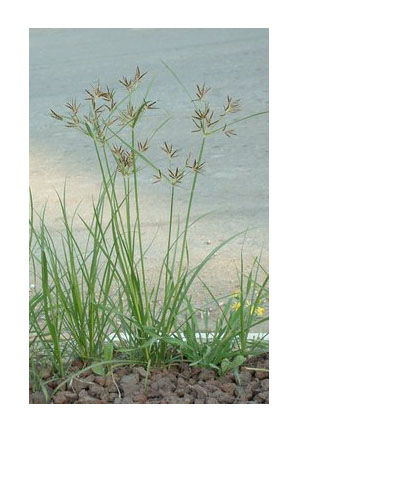Nagarmotha
Latin: Cyperus Rotundus
Therapeutic Action:
The rhizome contains: flavonoids, alkaloids, saponins and fatty oils (glycerides). Action & uses: Stimulant, tonic, demulent, diuretic, anthelmintic, stomache, carminative, diaphoretic, astringent, emmenagogue and vermifuge. Properties & Actions:Alterative, Analgesic, Antibacterial, Anti-inflammatory, Antimalarial, Antimicrobial, Anti-pyretic, Astringent, Carminative, Demulcent, Diaphoretic, Diuretic, Emmenagogueue, Emollient, Febrifuge, Hypoglycemic, Hypotensive, Immunostimulant, Nervine, Stimulant, Stomachic, Tonic, Vermifuge Applications: Cyperus is mainly used for digestive disorders. It is an anti-emetic (suppresses vomiting); useful in reducing the symptoms of morning sickness during pregnancy. Because it gives the body a general feeling of warmth. Cyperus is sometimes used as a sedative, generally in connection with suppressing nausea. Cyperus is also used to relieve gas in the stomach and intestines. In Amazonia, the indigenous people use it to treat infection and in Africa it is used to treat epilepsy. Properties: analgesic, anthelmintic, antibacterial, antifungal, antispasmodic, astringent, carminative, emmenagogue, hypotensive, sedative, tonic. It is used for the liver, menstrual disorders, menstrual pain, as a digestive stimulant and for memory. It is also used to treat diarrhea, gas and infertility. It can help with some kinds of cervical cancer. The calming effect helps relieve depression Uses & Scientific Evidence Nutgrass is used to treat poor appetite, diarrhea, dysentery, fevers, parasites, gastritis, indigestion, and sluggish liver. It is said to tone the liver, spleen, and pancreas, and to treat malabsorption. Nutgrass can also be used to treat high blood pressure, bloody stool and urine, and vomiting blood, breast tumors, candida, colds, flu, and colic. It helps treat convulsions, moodiness and depression, premenstrual syndrome (PMS) and the pain and cramps associated with PMS, menopause, and heart palpitations. In India they use Nutgrass in hair and skin products as it stimulates sebaceous glands near the hair roots. The oil extracted from this plant is used in perfumery. A decoction of the roots and tubers is used as an antidote to any kind of poison. Medicinal Uses Analgesic; Antibacterial; Antibiotic; Antispasmodic; Antitussive; Aromatic; Astringent; Carminative; Contraceptive; Diaphoretic; Diuretic; Emmenagogue; Lithontripic; Sedative; Skin; Stimulant; Stomachic; Tonic; Vermifuge. Nut grass is a pungent bitter-sweet herb that relieves spasms and pain, acting mainly on the digestive system and uterus[238]. The roots and tubers are analgesic, antibacterial, antispasmodic, antitussive, aromatic, astringent, carminative, diaphoretic, diuretic, emmenagogue, litholytic, sedative, skin, stimulant, stomachic, tonic and vermifuge[116, 145, 147, 152, 176, 218, 238, 240]. They are used internally in the treatment of digestive problems and menstrual complaints[238]. The roots are harvested in the summer or winter and are dried for later use[238]. An essential oil in the tubers has antibiotic activity and has been shown to arrest the growth of Micrococcus pyrogenes[240]. The plant is rated 8th amongst 250 potential antifertility plants in China[218]. The plant is used in the treatment of cervical cancer[218].
References:
- Nadkarni, Vol I, Page 429-430
- Paranjape Pages 177-178
- Nadkarni, Vol I, P 428-429
- Paranjape P 175- 176
Used in:
- Entrox Forte Tablets
- Lekorin Tablets / Lekoril Syrup
- Livonex Tablets
- Citazil Syrup
- Entrox Syrup / Unexozim Syrup
- Kufrex Syrup
- Examil Cream

Copyright 2013 Unexo Laboratories Pvt. Ltd. All Rights Reserved. Designed & Developed By: Credence Technologies


